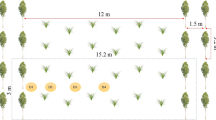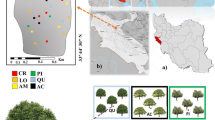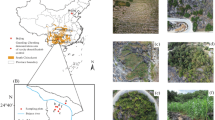Abstract
This paper attempts to provide a new perception of the weed Chromolaena odorata (Asteraceae) which is considered as a plague in agriculture or as a soil fertility indicator. The study was conducted in the forest-savanna transition zone of Côte d’Ivoire and aimed to compare soil biological activity and plant nutrient availability under three well-represented vegetation features, including C. odorata lands (ChrO), shrub savannas (ShrS), and grass savannas (GraS). Each of these vegetation features included five plot replicates (50 m × 50 m size) distributed in the landscape. Soil chemical parameters such as pH, organic matter, soluble phosphorus, exchangeable bases, and biological parameters such as abundance and diversity of earthworms, and soil enzymatic activities were investigated. Composite soil samples were collected and analyzed for chemical and microbial parameters while earthworms were sampled using the Tropical Soil Biology and Fertility 25 × 25 × 30 cm soil monolith method. A principal component analysis showed a clear demarcation between C. odorata plots and the savanna ones. Soluble P and exchangeable bases were significantly higher under ChrO than under both savannas. Earthworm density was twice higher under ChrO (433.3 ± 90.8 ind m−2) than under ShrS (173.9 ± 61.5 ind m−2) and GraS (176.0 ± 40.6 ind m−2) and this was accounted for by the abundance of detritivores and polyhumics. Acid and alkaline phosphatase activities under ChrO (2.9 ± 0.2 and 2.5 ± 0.3 μmol pNP g−1 soil h−1, respectively) were twice higher than under both savannas. Based on the fact that ChrO and ShrS were located on similar soil types and had the same topographic position, we concluded that the establishment of C. odorata in a savanna land and its subsequent high biomass and quality-litter production were mostly the reasons of the improvement in soil biology and plant nutrient availability. Between-savanna comparison showed that ShrS, with higher CEC and exchangeable bases, was somewhat more fertile than GraS, probably because of a better soil physical status. In view of the agronomic potentials of the shrub C. odorata, it may be taken as a basis for improved fallow in Africa.



Similar content being viewed by others
References
Acosta-Martinez V, Cruz L, Sotomayor-Ramirez D, Pérez-Alegria L (2007) Enzyme activities as affected by soil properties and land use in a tropical watershed. Appl Soil Ecol 35:35–45
Anderson JM, Ingram JSI (1993) Tropical soil biology and fertility, a handbook of methods, 2nd edn. CAB International, New York
Araujo Y, Luizao FJ, Barros E (2004) Effect of earthworm addition on soil nitrogen availability, microbial biomass and litter decomposition in mesocosm. Biol Fertil Soils 39:146–152
Bhadauria T, Saxena KG (2010) Role of earthworms in soil fertility maintenance through the production of biogenic structures. Appl Environ Soil Sci 2010:1–7
Blanchart E, Lavelle P, Baudeau E, LeBissonnais Y, Valentin C (1997) Regulation of soil structure by geophageous earthworm activities in humid savannas of Côte d’Ivoire. Soil Biol Biochem 29:431–439
Bouadi LEC (2009) Rôle des jachères à Chromoleana odorata dans le terroir du village d’Ahérémou-2. DUT dissertation, URES-Korhogo, Université de Bouaké
Cong PT, Merckx R (2005) Improving phosphorus availability in two soils of Vietnam using Tithonia diversifolia H. Plant Soil 269:11–23
Dossa EL, Diedhiou S, Compton JE, Assigbetse KB, Dick RP (2010) Spatial patterns of P fractions and chemical properties in soils of two native shrub communities in Senegal. Plant Soil 327:185–198
Dove MR (1986) The practical reason for weeds in Indonesia: peasant versus state views of Imperata and Chromolaena. Hum Ecol 14:163–190
Eivazi F, Tabatabai MA (1988) Glucosidases and galactosidases in soil. Soil Biol Biochem 20:601–606
Gautier L (1992) Contact forêt-savane en Côte d’Ivoire centrale: Rôle de Chromolaena odorata (L.) R. King et H. Robinson dans la dynamique de la végétation. Thèse, Université de Genève, Suisse
Goma-Tchimbakala J, Bernhard-Reversat F (2006) Comparison of litter dynamics in three plantations of an indigenous timber-tree species (Terminalia superba) and a natural tropical forest in Mayombe, Congo. For Ecol Manag 229:304–313
Goodall JM, Erasmus DJ (1996) Review of the status and integrated control of the invasive alien weed, Chromolaena odorata in South Africa. Agric Ecosyst Environ 56:151–164
Gunasekera TGL, Rajapakse CNK (1994) Paraeuchaetes pseudoinsulata as a possible biological control agent for Chromolaena odorata. Planter 70:387–393
Ha KV, Marschner P, Bünemann EK, Smernik RJ (2007) Chemical changes and phosphorus release during decomposition of pea residues in soil. Soil Biol Biochem 39:2696–2699
Hassink J (1997) The capacity of soils to preserve organic C and N by their association with clay and silt particles. Plant Soil 191:77–97
Huguenin J, Bedogo B, Deat M (1992) Herbicide trials on Siam weed in pastures of the Central African Republic. In: 15ème Conférence du COLUMA: Lutte Contre les Mauvaises Herbes, 2–4 Décembre, Versailles, France, pp 1257–1264
Jamaludheen V, Kumar BM (1999) Litter of multipurpose trees in Kerala, India: variations in the amount, quality, decay rates and release of nutrients. For Ecol Manag 115:1–11
Kizito F, Sene M, Dragila MI, Lufafa A, Diedhiou I, Dossa E, Cuenca R, Selker JS, Dick RP (2007) Soil water balance of annual crop-native shrub systems in Senegal’s Peanut basin: the missing link. Agric Water Manag 90:137–148
Kluge RL, Zachariades C (2006) Assessing the damage potential of the stem-boring weevil Lixus aemulus for the biological control of Chromolaena odorata. Biocontrol 51:547–552
Koné WA (2009) Qualité des sols en zone de savane humide de Côte d’Ivoire: utilisation des légumineuses herbacées comme alternative pour une valorisation des terres marginales et une agriculture durable. PhD dissertation, Université d’Abobo-Adjamé, Côte d’Ivoire
Koné WA, Tondoh EJ, Angui KTP, Bernhard-Reversat F, Loranger-Merciris G, Brunet D, Brédoumi KTS (2008) Is soil quality improvement by legume cover crops a function of the initial soil chemical characteristics? Nutr Cycl Agrosyst 82:89–105
Koné WA, Edoukou FE, Tondoh EJ, Gonnety TJ, Angui KTP, Masse D (2012a) Comparative study of earthworm communities, microbial biomass and plant nutrient availability under one-year Cajanus cajan (L.) Millsp and Lablab purpureus (L.) Sweet cultivations versus natural regrowths in a guinea savanna zone. Biol Fertil Soils 48:337–347
Koné WA, Edoukou FE, Orendo-Smith R, Tondoh EJ (2012b) Earthworms in Chromolaena odorata (L.) King and Robinson (Asteraceae) fallows along a chronosequence: changes in community structure and identification of persistent and indicator species. Pedobiologia. doi:10.1016/j.pedobi.2012.02.001
Kouassi KG (2010) Indicateurs de l’état de la fertilité des terres en milieu paysan: exemple du village d’Ahérémou-2 (Centre de la Côte d’Ivoire). DUT dissertation, URES-Korhogo, Université de Bouaké
Koutika L-S, Rainey HJ (2010) Chromolaena odorata in different ecosystems: weed or fallow plant? Appl Ecol Environ Res 8:131–142
Koutika L-S, Hauser S, Meuteum Kamga JG, Yerima B (2004) Comparative study of soil properties under Chromolaena odorata, Pueraria phaseoloides and Calliandra calothyrsus. Plant Soil 266:315–323
Lal R (1997) Soil carbon sequestration impacts on global climate change and food security. Science 304:1623–1627
Lavelle P (1981) Stratégies de reproduction chez les vers de terre. Acta Oecol Oecol Gen 2:117–133
Lavelle P, Decaëns T, Aubert M, Barot S, Blouin M, Bureau F, Margerie P, Mora P, Rossi J-P (2006) Soil invertebrates and ecosystem services. Eur J Soil Biol 42:3–15
Lee KE (1985) Earthworms: their ecology and relationships with soils and land use. Academic Press, Sydney
Loranger G, Ponge J-F, Imbert D, Lavelle P (2002) Leaf decomposition in two semi-evergreen tropical forests: influence of litter quality. Biol Fertil Soils 35:247–252
Lynch J (1995) Root architecture and plant productivity. Plant Physiol 109:7–13
Magurran AE (2004) Measuring biological diversity. Blackwell Publishing, Oxford
Mainoo N-OK, Whalen JK, Barrington S (2008) Earthworm abundance related to soil physicochemical and microbial properties in Accra, Ghana. Afr J Agric Res 3(3):186–194
Mboukou-Kimbasta I, Bernhard-Reversat F, Loumeto J-N, Ngao J, Lavelle P (2007) Understorey vegetation, soil structure and soil invertebrates in Congolensis Eucalypt plantations, with special reference to the invasive plant Chromolaena odorata and earthworm populations. Eur J Soil Biol 47:48–56
Menaut JC (1971) Etude de quelques peuplements ligneux d’une savane guinéenne de Côte d’Ivoire. PhD dissertation, Faculté des Sciences de Paris, Paris
Mora P, Seuge C, Chotte JL, Rouland C (2003) Physico-chemical typology of the biogenic structures of termites and earthworms: a comparative analysis. Biol Fert Soils 37:245–249
Muniappan R, Reddy GVP, Lai P-Y (2005) Distribution and biological control of Chromolaena odorata. In: Inderjit S (ed) Invasive plants: ecological and agricultural aspects. Birkhaüser Verlag AG, Basel, pp 223–233
Murphy J, Riley JP (1962) A modified single solution method for the determination of phosphate in natural waters. Anal Chim Acta 27:31–36
Nelson DW, Sommers LE (1980) Total nitrogen analysis for soil and plant tissues. J Assoc Offic Anal Chem 63:770–778
Nelson DW, Sommers LE (1982) Total carbon, organic carbon, and organic matter, part 2. In: Page AL, Miller RH, Keeney DR (eds) Methods of soil analysis, 2nd edn. American Society of Agronomy, Madison, pp 539–579
Obatolu CR, Agboola AA (1993) The potential of Siam weed (Chromolaena odorata) as a source of organic matter for soils in humid tropics. In: Mulongoy M, Merckx R (eds) Soil organic matter dynamics and sustainability of tropical agriculture. Wiley-Sayce Co, New York, pp 89–99
Olabode OS, Sola O, Akanbi WB, Adesina GO, Babajide PA (2007) Evaluation of Tithonia diversifolia (Hemsl.) A gray for soil improvement. World J Agric Sci 3:503–507
Olsen SR, Sommers LE (1982) Phosphorus. In: Page AL, Miller RH, Keeney DR (eds) Methods of soils analysis, part 2, 2nd edn. American Society of Agronomy, Madison, pp 403–430
Onguene NA (2007) Mycorrhizal associations as indicators of forest quality after land use practices. In: Bationo A, Waswa B, Kihara J, Kimetu J (eds) Advances in soil fertility management in sub-Saharan Africa: challenges and opportunities, Springer, The Netherlands, pp 845–853
Parham JA, Deng SP (2000) Detection, quantification and characterization of β-glucosaminidase activity in soil. Soil Biol Biochem 32:1183–1190
Pielou EC (1966) The measurement of diversity in different types of biological collections. J Theor Biol 13:213–226
Quansah C, Fening JO, Ampontuah EO, Afreh D, Amin A (2001) Potential of Chromolaena odorata, Panicum maximum and Pueraria phaseoloides as nutrient sources and organic matter amendments for soil fertility maintenance in Ghana. Biol Agric Hortic 19:101–113
Riou G (1974) Les sols de la savane de Lamto. Bulletin de Liaison des Chercheurs de Lamto 1:3–45
Roder W, Phengchanh S, Keoboualapha B, Maniphone S (1995) Chromolaena odorata in slash-and-burn rice systems of Northern Laos. Agrofor Syst 31:79–92
Scheu S (2003) Effects of earthworms on plant growth: patterns and perspectives. Pedobiologia 47:1–11
Setter MJ, Campbell SD (2002) Impact of foliar herbicides on germination and viability of Siam weed (Chromolaena odorata) seeds located on plants at the time of application. Plant Prot Quart 17:155–157
Slaats JPP (1995) Chromolaena odorata fallow in food cropping systems: an assessment in South-West Ivory Coast. PhD Thesis, University of Wageningen
Tabatabai MA, Bremner JM (1969) Use of p-nitrophenyl phosphate for assay of soil phosphatase activity. Soil Biol Biochem 1:301–307
Taillez B (1992) Chromolaena odorata control using 2,4-d amine. Oleagineux 47:143–149
Technicon Industrial Systems (1977) Individual/simultaneous determination of nitrogen and/or phosphorus in BD acid digests. Technicon Industrial Systems, Tarrytown
Thioulouse J, Chessel G, Dolédec S, Olivier JM (1997) ADE-4: a multivariate analysis and graphical display software. Stat Comput 7:75–83
Thomas GW (1982) Exchangeable cations. In: Page AL, Miller RH, Keeney DR (eds) Methods of soil analysis, 2nd edn. Agron Monogr 9. American Society of Agronomy, Madison, pp 159–164
Tondoh EJ (2006) Seasonal changes in earthworm diversity and community structure in Central Côte d’Ivoire. Eur J Soil Biol 42:334–340
Vuattoux R (1976) Contribution à l’étude de l’évolution des strates arborées et arbustives dans la savane de Lamto (Côte d’Ivoire). Ann Univ Abidjan, série C 12:35–61
Acknowledgments
This study was funded by the French Ministry of Foreign and European Affairs, through the research program AIRES-Sud, implemented by the Institut de Recherche pour le Développement (IRD-DSF). We are grateful to R. Orendo-Smith for his contribution in editing the text, and the two anonymous referees for their valuable inputs. Special thanks to the farmers from the village Ahérémou-2 for their active participation in the project AJAMSA.
Author information
Authors and Affiliations
Corresponding author
Rights and permissions
About this article
Cite this article
Koné, A.W., Edoukou, E.F., Gonnety, J.T. et al. Can the shrub Chromolaena odorata (Asteraceae) be considered as improving soil biology and plant nutrient availability?. Agroforest Syst 85, 233–245 (2012). https://doi.org/10.1007/s10457-012-9497-5
Received:
Accepted:
Published:
Issue Date:
DOI: https://doi.org/10.1007/s10457-012-9497-5




